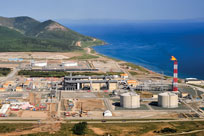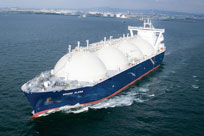Boxscore Construction Analysis
Eugene Gerden, Contributing Writer
Despite Western sanctions, Russian natural gas producer Gazprom, together with partner Shell, plans to start building the third stage of the LNG plant on Sakhalin Island. The project will be implemented as part of the Sakhalin-2 oil and gas development, which encompasses the first LNG export plant in Russia (Fig. 1), according to Gazprom’s deputy chairman, Alexander Medvedev.
 |
|
Fig. 1. The Sakhalin-2 development in |
FID fast-tracked. A final investment decision (FID) on the third stage of the Sakhalin-2 LNG project was not scheduled to be made before 2017; however, the partners have decided to speed up the process.
Implementation of the project came under serious threat after a recent decision by the US government to include the South Kirinskoye condensate field—a field located on the shelf of Sakhalin and a base for the Sakhalin projects—in the sanctions’ blacklist. This decision resulted in the automatic introduction of a ban on supply equipment for the project from US companies, as well as other restrictions. The US government said the sanctions decision was made due to the “significant reserves of the field.”
The blacklisting poses a serious threat for the implementation of the project, because gas production at the South Kirinskoye field will require the use of special subsea production systems, due to the depth of the sea and difficult ice conditions. These systems, however, are not produced in Russia; they are manufactured in the US. In addition, Russia may face a shortage of large-scale liquefaction technology as a result of the sanctions extension.
Prior to the sanctions, Gazprom and Shell had planned to source the needed equipment from US-based FMC Corp.; however, the imposition of the latest restrictions may force the partners to revise their earlier plan.
Project progress continues. Despite the sanctions extension, implementation of the project will continue, since Shell does not plan to leave Russia or the Sakhalin-2 project. Gazprom and Shell signed an agreement for the building of the third stage of the plant in June during the St. Petersburg Economic Forum.
At present, the overall capacity of the Sakhalin-2 LNG terminal is approximately 10.8 metric MMtpy. The third stage of the LNG plant is expected to increase the overall production volume of Sakhalin-2 by 1.5 times, to 15 metric MMtpy of LNG, upon startup in 2018 or 2019.
Olivier Lazare, head of Shell Russia, confirmed that Shell has completed the design of its double mixed-refrigerant (DMR) process for the third stage of the LNG terminal. This technology will be essential for proper operation of the plant in Russia’s cold climate.
The project also involves the development of the Piltun-Astokhskoye oil field and the Lunskoye natural gas field offshore Sakhalin Island in the Okhotsk Sea, along with associated onshore infrastructure.
The Sakhalin-2 development is managed and operated by Sakhalin Energy Investment Company Ltd. (Sakhalin Energy). Gazprom’s share in Sakhalin Energy is 50% plus one share, while Shell holds 27.5% minus one share. Other shareholders include Mitsui (12.5%) and Mitsubishi (10%).
Investment in the commissioning of the third stage of the terminal is anticipated at $7.4 B. The funds are expected to be provided by Russian, Chinese and Japanese banks, and loan negotiations have already commenced.
According to Alexey Miller, head of Gazprom, the launch of the third stage of the plant will allow an increase in LNG supplies to both the domestic and foreign markets—in particular, Asia-Pacific markets, where demand for LNG has significantly increased in recent years. The potential also exists for some LNG exports to be sent to the Middle East, specifically Kuwait.
For the domestic market, the launch of the third stage will facilitate an increase in the volume of LNG supplies to Russia’s Far East region, which is experiencing a shortage of stable gas supplies.
Sakhalin-2 exports seen steady. According to Roman Dashkov, head of Sakhalin Energy, the volume of LNG produced at Sakhalin-2 will remain at 10.8 metric MMt in 2016, which is comparable to the anticipated final production figure for the current year, despite sluggish demand in the Asian market. This volume is equivalent to approximately 4% of global LNG production.
According to Dashkov, of the 10.8 metric MMt of LNG that were produced in 2014 at the Sakhalin-2 LNG terminal, approximately 80% of the product was shipped to Japan, and 18% was sent to Korea. The remaining volumes were delivered to China, Taiwan and Thailand (Fig. 2). Despite low global prices for LNG, Dashkov confirmed that Gazprom does not plan to revise the project or reduce its production over the near term.
 |
|
Fig. 2. In 2014, Sakhalin-2 added more |
Additionally, the company plans to take a stake in one of Shell’s foreign LNG projects—possibly one of those under the operation of UK-based BG Group, which Shell recently acquired for $70 B.
Russia sharpens focus on LNG. According to Denis Khramov, Russia’s first deputy minister of natural resources and environment, the development of the domestic LNG industry will be one of the Russian government’s top priorities during the next several years. Khramov expects total exports of Russian LNG to reach 40 metric MMt by 2030, with most supplies flowing to China, India, South Korea and Japan.
The same position is shared by Alexander Novak, Russia’s minister of energy, who believes that the successful implementation of Russian LNG projects will increase the country’s global LNG market share to 12% over the next 10 years.
The Russian government aims to boost its LNG export volume to Japan from 8 metric MMt to 16 metric MMt. At the same time, it hopes to increase LNG exports to other Asia-Pacific nations. To achieve these goals, Russia plans to further liberalize its LNG market by granting permission to foreign companies to export Russian LNG abroad.
The successful commissioning of the third stage of the Sakhalin-2 LNG terminal will pave the way for the construction of a fourth stage in the near future.
A spokesman for Russia’s Ministry of Energy said that Shell’s main interest in Russia is mostly associated with local production assets, such as LNG plants, terminals and gas fields. For Gazprom, strengthening its cooperation with Shell will provide the company an access to new sales markets and customers. Additionally, Gazprom is very interested in the increase of LNG exports abroad—because LNG global supplies have increased significantly in recent years, the share of pipeline gas sales, Gazprom’s main focus, in the global market is rather limited.
Meanwhile, Shell’s goal to increase its portfolio of Russian LNG is being realized not only through the cooperation with Gazprom. In early June, the company signed a 20-year contract with Novatek for the purchase of 0.9 MMtpy of LNG from Novatek’s Yamal LNG, a proposed LNG plant at Sabetta, northeast of the Yamal Peninsula, that will have a capacity of 16.5 MMtpy of LNG. GP
 |
Eugene Gerden is an international contributing writer specializing in the global oil refining and gas industry. He has been published in a number of prominent industry titles.




Comments